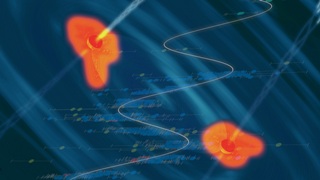Jan 8 2015
The central regions of many glittering galaxies, our own Milky Way included, harbor cores of impenetrable darkness -- black holes with masses equivalent to millions, or even billions, of suns. What's more, these supermassive black holes and their host galaxies appear to develop together, or "co-evolve." Theory predicts that as galaxies collide and merge, growing ever more massive, so too do their dark hearts.
 An artist's conception of a black hole binary in a heart of a quasar, with the data showing the periodic variability superposed. Credit: Santiago Lombeyda, Center for Data-Driven Discovery, Caltech.
An artist's conception of a black hole binary in a heart of a quasar, with the data showing the periodic variability superposed. Credit: Santiago Lombeyda, Center for Data-Driven Discovery, Caltech.
Black holes by themselves are impossible to see, but their gravity can pull in surrounding gas to form a swirling band of glowing material called an accretion disk. When this process happens to a supermassive black hole, the result is a "quasar" -- an extremely luminous object that outshines all of the stars in its host galaxy, visible from across the universe.
"Quasars are valuable probes of the evolution of galaxies and their central black holes," said S. George Djorgovski, professor of astronomy at the California Institute of Technology in Pasadena. "If we can systematically study a large population of quasars, we can discover rare and unusual phenomena that can help us better understand the overall picture of their evolution."
In the Jan. 7 issue of the journal Nature, Djorgovski and his collaborators, including Daniel Stern of NASA's Jet Propulsion Laboratory in Pasadena, California, report on an unusual repeating light signal from a distant quasar that they say is most likely the result of two supermassive black holes in the final stages of a merger -- something that is predicted from theory but which has never been observed before. The findings could lead to a better understanding of black hole mergers and galaxy evolution, and also help shed light on a long-standing conundrum in astrophysics called the "final parsec problem." That refers to the failure of theoretical models to predict what the final stages of a black hole merger look like, or even how long the process might take.
"Until now, the only known examples of supermassive black holes on their way to a merger have been separated by tens or hundreds of thousands of light-years," said Stern. "At such vast distances it would take many millions, or even billions, of years for a collision and merger to occur. In contrast, these black holes are at most a few hundredths of a light-year apart, and could merge in about a million years or less."
Read the full Caltech story online:
https://www.caltech.edu/news/unusual-light-signal-yields-clues-about-elusive-black-hole-merger-45188